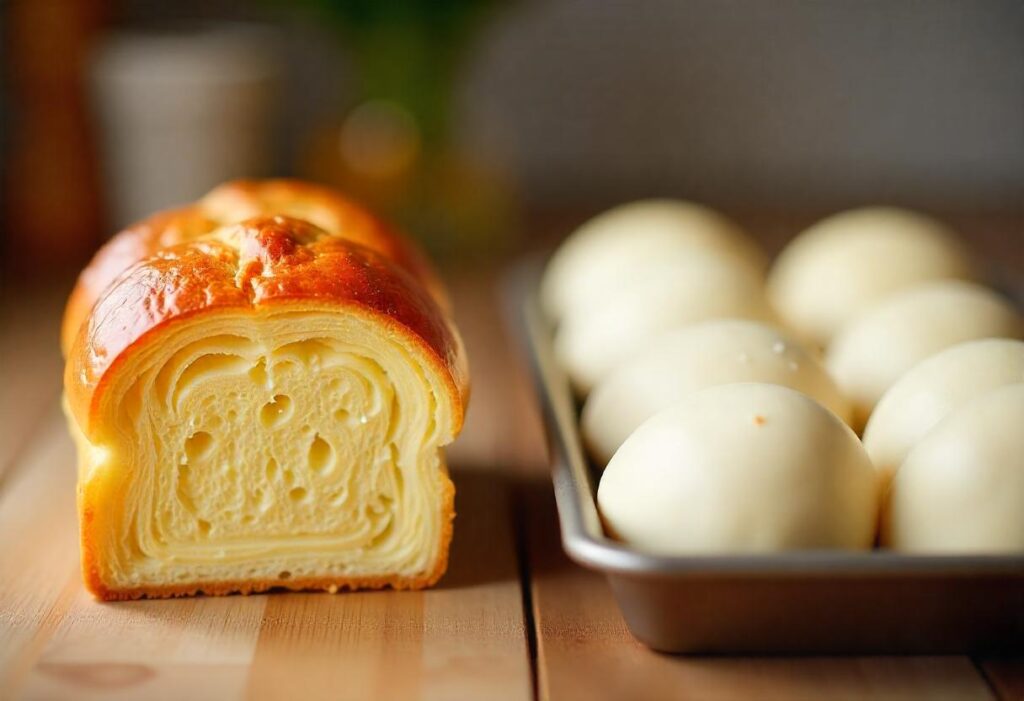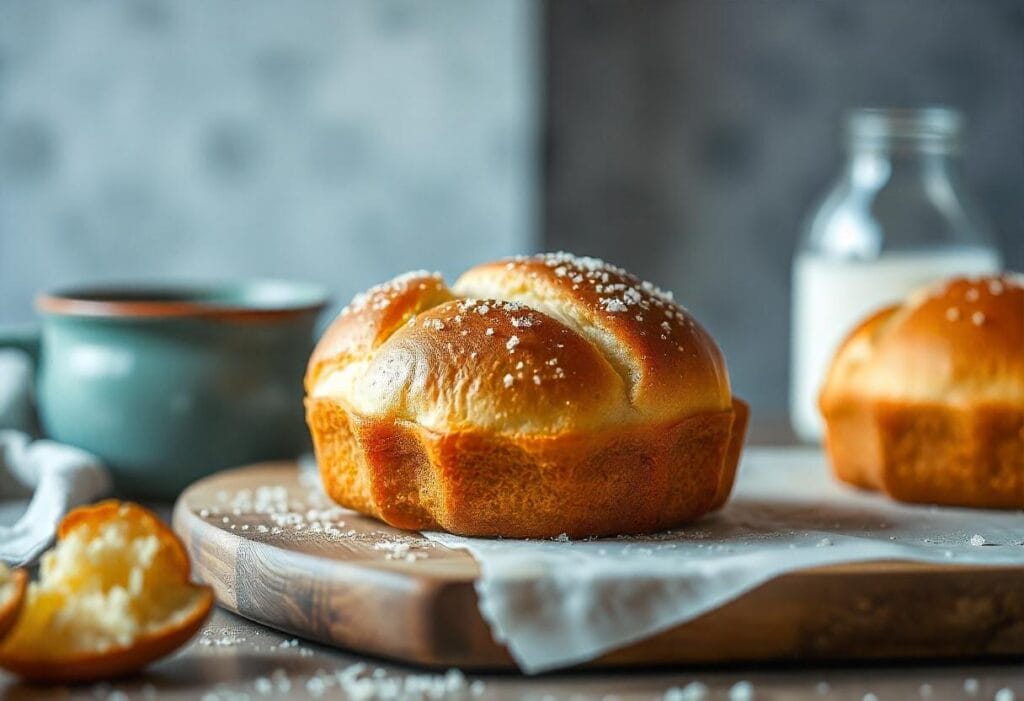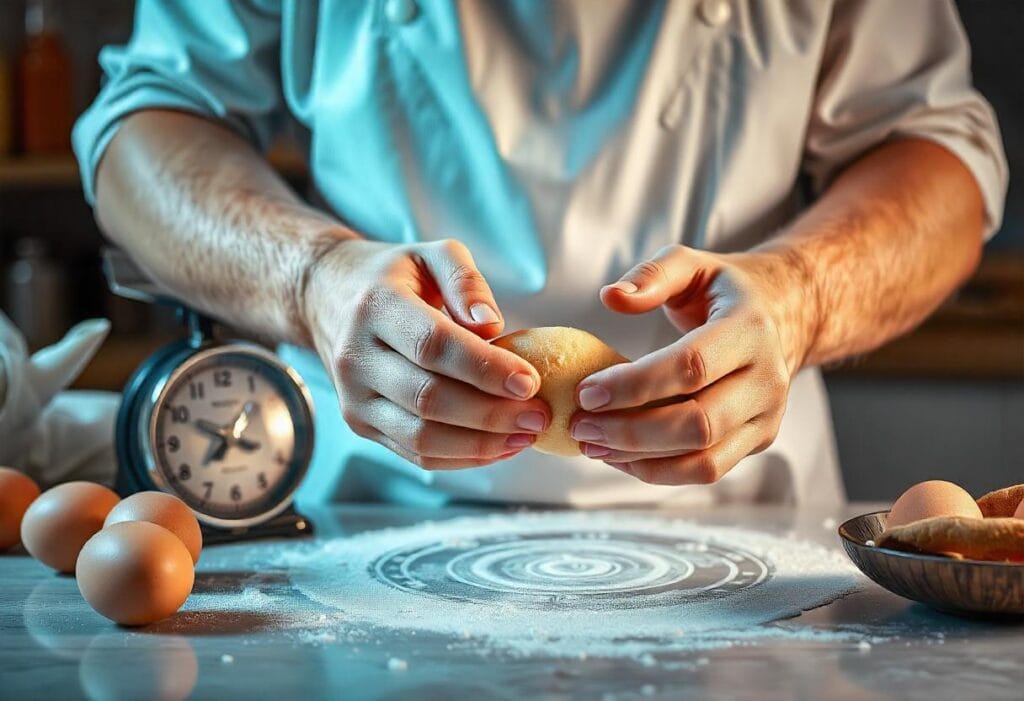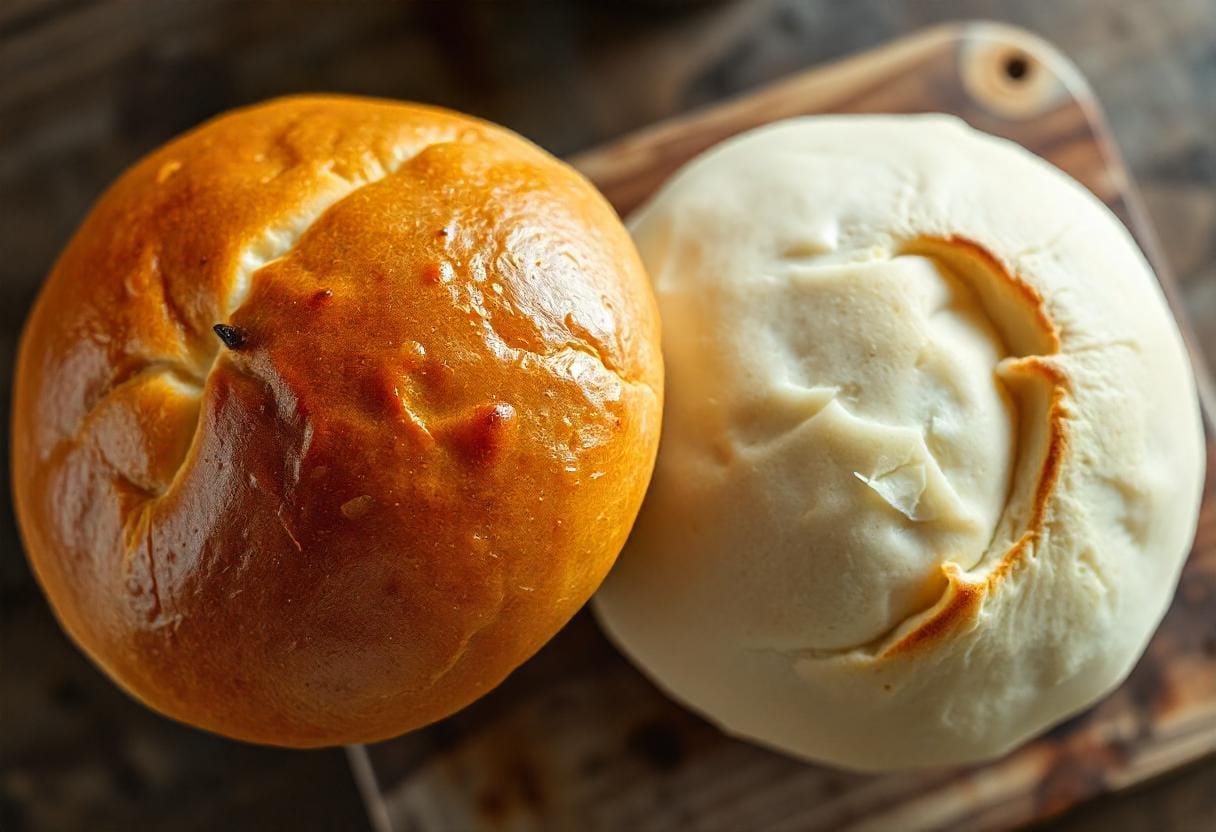Difference between brioche and milk buns is a culinary mystery that bread lovers everywhere are eager to solve! These two beloved bread types might look similar at first glance, but they couldn’t be more different. The difference between brioche and milk buns goes far beyond their soft exteriors, diving deep into ingredients, origins, and culinary uses. Let’s dive deep into the details to uncover their key differences and why you might choose one over the other.
For a more detailed look at what sets brioche apart, check out « What is the difference between brioche? ».
Understanding what is the difference between brioche and milk buns can help you make the best choice for your recipe or dietary needs
Bread lovers, rejoice! Brioche and milk buns are two beloved bread types that can elevate any meal. While they both fall into the « soft bread » category, each offers distinct textures, flavors, and culinary uses. So, what’s the real story behind these two? Let’s explore!
Brioche: The Luxurious Side of the Difference
If you’ve ever wondered what is the difference between brioche and milk buns, brioche stands out as the queen of bread—and for good reason! Originating in France, it’s a decadent bread made with generous amounts of butter and eggs. The result? A bread that’s almost like a dessert. Think of it as the bread equivalent of a cashmere sweater: rich, luxurious, and oh-so-satisfying.
Milk Buns: The Subtle Contrast in the Difference
Milk buns, on the other hand, are all about simplicity and softness. Popular in Asian and Western cuisines alike, they use milk or cream to create a delicate texture. If brioche is a cashmere sweater, milk buns are like your favorite hoodie—comfortable, reliable, and perfect for everyday use.
Key Ingredients That Differentiate Brioche and Milk Buns
Bread recipes are like secret formulas, and the ingredients are the key to their differences.

Brioche Ingredients: Richness in Butter and Eggs
Brioche stands out for its high fat content. It’s made with:
- Butter: Adds richness and flavor.
- Eggs: Provide structure and a golden hue.
- Sugar: Enhances sweetness.
- Flour: The backbone of the bread.
- Milk/Water: Moisture for the dough.
This combination creates a bread that’s both fluffy and rich—a perfect balance that feels indulgent with every bite.

Milk Bun Ingredients: Simplicity with a Creamy Touch
Part of understanding what is the difference between brioche and milk buns lies in how milk buns focus on creaminess and softness rather than richness. Their key ingredients include:
- Milk: Adds moisture and a creamy taste.
- Butter (or Oil): For softness.
- Sugar: Subtle sweetness.
- Flour: Keeps it sturdy yet fluffy.
- Yeast: Helps the dough rise.
Here’s a quick ingredient comparison table:
| Ingredient | Brioche | Milk Buns |
|---|---|---|
| Butter | High amount | Low to medium |
| Eggs | Essential | Rarely used |
| Milk | Optional | Essential |
| Sugar | Moderate to high | Low to moderate |
| Flour | Bread or all-purpose | Bread or all-purpose |
📝 Fun Fact: Milk buns are often made with tangzhong, a roux-like paste that makes the bread extra soft. Brioche skips this step but compensates with its rich ingredients.
Texture and Appearance: How They Differ
Understanding what is the difference between brioche and milk buns is especially helpful when comparing texture and appearance—they’re easy to distinguish once you know what to look for.
Brioche: Light and Buttery Layers
Brioche has a light, airy texture with a tender crumb. The butter and eggs give it a golden-brown crust and a rich yellow interior. It’s like biting into a fluffy, buttery cloud.
“Brioche feels more like a pastry than bread—it’s an experience in every bite.”
Milk Buns: Pillow-Soft and Smooth
Milk buns, meanwhile, are incredibly soft and smooth, with a creamy, velvety texture. The crust is thin and almost melts into the bread itself. Picture this: pulling apart a milk bun is like tearing through cotton candy—soft, effortless, and satisfying.
Flavor Profiles: Sweet vs. Subtle
One of the clearest ways to see what is the difference between brioche and milk buns is by comparing their taste: brioche is sweet and rich, while milk buns are neutral and creamy.
Brioche Flavor: Rich, Sweet, and Buttery
Brioche leans toward the sweet side, with buttery richness dominating the flavor. It’s perfect for dishes like French toast, bread pudding, or even paired with savory toppings like smoked salmon.
Milk Bun Flavor: Neutral Yet Creamy
Milk buns are more subtle in flavor. Their mild sweetness and creamy notes make them incredibly versatile. Whether it’s a burger, a jam spread, or pulled pork, milk buns are up for the job.
Cultural Origins and History
When exploring what is the difference between brioche and milk buns, cultural origin plays a key role in shaping how each is prepared and enjoyed.
Brioche: A French Legacy
Brioche has been a staple in French bakeries for centuries. Its luxurious ingredients were once a symbol of wealth, often enjoyed by royalty. Today, it’s a worldwide favorite.
Milk Buns: Asian Inspiration Meets Modern Baking
Milk buns trace their roots to Japan, where the tangzhong method revolutionized bread baking. This technique spread across Asia and the world, making milk buns a global phenomenon.
Table: Quick Comparison of Brioche vs. Milk Buns
| Feature | Brioche | Milk Buns |
|---|---|---|
| Texture | Light, buttery, airy | Soft, smooth, fluffy |
| Flavor | Sweet, buttery | Subtle, creamy |
| Key Ingredients | Butter, eggs, sugar | Milk, sugar, tangzhong |
| Cultural Origin | France | Japan/Asia |
| Popular Uses | French toast, desserts | Burgers, sandwiches |
Common Uses in Baking and Meals
The versatility of these breads shines in the kitchen.
Brioche in Gourmet Dishes
Brioche is the star of many indulgent dishes:
- French Toast: The richness of brioche elevates this classic breakfast.
- Bread Pudding: Its buttery crumb absorbs flavors beautifully.
- Savory Sandwiches: Think lobster rolls or smoked salmon sliders.
Milk Buns in Everyday Comfort Food
Milk buns are perfect for simple, comforting meals:
- Burgers: Their softness makes them ideal for juicy patties. 🍔
- Sweet Treats: Spread with jam, honey, or condensed milk.
- Savory Fillings: Pulled pork or fried chicken pair wonderfully.
Comparing Nutritional Profiles
When choosing between brioche and milk buns, knowing their nutritional differences can help guide your decision—especially if you’re keeping an eye on your health.
Calories, Fats, and Carbohydrates
Brioche is typically higher in calories and fats because of its rich ingredients like butter and eggs. Milk buns, while softer, tend to be lower in fat but can have slightly higher carbs due to their milk-based dough.
Here’s a side-by-side nutrition table for a standard serving size (1 slice or bun, about 50g):
| Nutrient | Brioche | Milk Bun |
|---|---|---|
| Calories | 150–170 kcal | 120–140 kcal |
| Total Fat | 6–8g | 3–5g |
| Saturated Fat | 4–5g | 1–2g |
| Carbohydrates | 20–25g | 25–28g |
| Protein | 4–6g | 3–4g |
📝 Pro Tip: If you’re calorie-conscious, milk buns are often the lighter choice. However, brioche is hard to beat when you’re craving indulgence.
Suitability for Special Diets
- Brioche: Its reliance on butter and eggs makes it unsuitable for vegan diets, though there are plant-based alternatives.
- Milk Buns: These can be more adaptable for vegan versions by swapping milk and butter for plant-based substitutes.
Popular Recipes for Brioche and Milk Buns
Why not try baking these beauties at home? Here are simple, crowd-pleasing recipes for each.
Classic Brioche Recipe
Ingredients:
- 3 1/2 cups of bread flour
- 1/4 cup sugar
- 1 tsp salt
- 1 packet active dry yeast
- 4 large eggs
- 1/2 cup butter, softened
Steps:
- Mix flour, sugar, salt, and yeast in a large bowl.
- Add eggs and knead until combined. Gradually incorporate butter until the dough is smooth.
- Let the dough rise for 1–2 hours, then shape it into loaves or rolls.
- Bake at 375°F (190°C) for 20–25 minutes or until golden brown.
Homemade Milk Buns Recipe
Ingredients:
- 3 cups bread flour
- 3 tbsp sugar
- 1 tsp salt
- 1 tbsp dry milk powder
- 1 cup warm milk
- 2 tbsp butter
Steps:
- Combine flour, sugar, salt, and milk powder. Add warm milk and knead until smooth.
- Incorporate butter and knead until elastic.
- Let rise for 1 hour, then shape into buns.
- Bake at 350°F (175°C) for 15–18 minutes until soft and golden.
Common Problems When Baking Brioche and Milk Buns
No one likes baking mishaps, but they’re a part of the journey. Here’s how to tackle common issues.

Challenges with Brioche: Kneading and Proofing
- Problem: The dough feels too sticky.
- Solution: This is normal for brioche! Use slightly floured hands but avoid over-flouring the dough—it’s supposed to be soft.
- Problem: Dense texture.
- Solution: Ensure you knead thoroughly and allow enough proofing time. Brioche needs patience!
Milk Bun Issues: Achieving the Perfect Texture
- Problem: Dry buns.
- Solution: Use the tangzhong method, which involves cooking a small portion of the flour and milk into a paste before adding it to the dough.
- Problem: Crust too hard.
- Solution: Brush with milk or butter before baking for a softer crust.
Solutions and Tips for Perfect Results
Mastering brioche and milk buns might take some trial and error, but these tips can make a big difference.
Mastering Brioche Baking
- Use room-temperature ingredients. This helps the dough come together smoothly.
- Don’t rush proofing. Brioche loves slow rises for maximum fluffiness.
- Invest in a stand mixer. Kneading rich dough by hand can be tough.
Secrets to Fluffy Milk Buns
- Try the tangzhong method. It’s a game-changer for ultra-soft buns.
- Keep the dough moist. Cover it with a damp cloth during proofing.
- Use warm milk. It activates the yeast better than cold liquid.
How to Choose Between Brioche and Milk Buns
Can’t decide? Let’s break it down.
Considering Occasion and Pairings
- Brioche: Ideal for fancy meals and sweet dishes like French toast or brioche bread pudding.
- Milk Buns: Perfect for casual settings like picnics, family dinners, or BBQs. 🍔
Balancing Flavor Preferences
- Choose brioche if you crave buttery richness.
- Opt for milk buns if you prefer a neutral, creamy base for toppings.
“Think of brioche as the star of the show and milk buns as the supporting cast—they’re both vital in different ways!”
Brioche and Milk Buns in Modern Cuisine
To fully grasp what is the difference between brioche and milk buns, it helps to see how both are used in creative modern dishes. Let’s look at how chefs and home cooks are embracing these breads.

Innovative Uses for Brioche
Brioche’s versatility allows it to shine in both sweet and savory dishes. Here are some innovative ways it’s being used today:
- Brioche Doughnuts: Imagine the buttery richness of brioche in a light, fluffy doughnut topped with icing or powdered sugar.
- Sliders: Mini brioche buns are perfect for gourmet sliders, like wagyu beef with caramelized onions and aioli.
- Brioche Pizza Crusts: For those who love a slightly sweet and buttery twist, brioche-based pizza crusts are a must-try.
« Brioche elevates the simplest recipes into something truly luxurious. It’s a bread that screams elegance in every bite! »
Modern Twists on Milk Buns
Milk buns are a favorite for creating fusion dishes due to their neutral, adaptable flavor. Some of the trendiest ways to use milk buns include:
- Korean-Inspired Sandwiches: Filled with spicy bulgogi beef, kimchi, and sesame mayo.
- Matcha Milk Buns: Infused with matcha powder for a lightly sweet, earthy flavor.
- Dessert Buns: Stuffed with custard, chocolate, or sweetened red bean paste for an indulgent treat.
Which Bread Is More Popular Globally?
The popularity of brioche and milk buns varies across cultures, but each has carved out a unique global presence.
Brioche’s Global Appeal
Brioche has become a staple in bakeries worldwide, particularly in Western countries. Its association with French cuisine gives it a sense of sophistication, making it a preferred choice for upscale dining. Dishes like brioche à tête (a classic French brioche with a knob-shaped top) remain iconic.
Milk Buns on the Rise
Milk buns, on the other hand, have surged in popularity thanks to the rise of Asian bakeries and cafes. In Japan, shokupan (Japanese milk bread) is a household staple, while in the West, milk buns are increasingly featured in food trucks and burger joints. Their soft, adaptable nature makes them a hit among diverse culinary traditions.
The Emotional Appeal of Bread
Let’s not forget the emotional connection we have with bread. Whether it’s the warm aroma of freshly baked brioche or the pillowy softness of a milk bun, both breads tap into a sense of comfort and nostalgia.
- Brioche: Feels indulgent and celebratory, often reminding us of festive gatherings.
- Milk Buns: Offer a sense of simplicity and home, perfect for everyday moments of joy.
Why Both Brioche and Milk Buns Deserve a Spot in Your Kitchen
Choosing between brioche and milk buns isn’t an either-or situation—they both have unique qualities that make them worth keeping in your culinary arsenal. Here’s why:
- Versatility: Both breads can adapt to a range of flavors, from sweet to savory.
- Ease of Baking: While brioche can be a bit more challenging, milk buns are beginner-friendly.
- Crowd-Pleasers: Their soft textures and delightful flavors appeal to kids and adults alike.
« At the end of the day, bread isn’t just food—it’s an experience. Discovering what is the difference between brioche and milk buns enhances your appreciation for both—the buttery richness of brioche and the comforting softness of milk buns each offer their own magic. »
Additional FAQs About Brioche and Milk Buns
6. Why Does Brioche Take Longer to Bake?
The high fat content in brioche requires longer baking times to ensure it’s fully cooked without being overly browned.
7. Are Milk Buns Gluten-Free?
Traditional milk buns aren’t, but gluten-free versions can be made using alternative flours like rice or almond flour.
8. How Can I Make Brioche Healthier?
You can reduce the butter content slightly or use alternatives like yogurt to cut back on fat while keeping it moist.
9. What’s the Shelf Life of Brioche and Milk Buns?
Both breads are best enjoyed fresh but can be stored for 2–3 days in airtight containers or frozen for up to 3 months.
10. Can I Use Brioche Dough for Pastries?
Absolutely! Brioche dough works wonderfully for pastries like cinnamon rolls or danishes due to its rich and fluffy texture.
For another take on the brioche vs. buns debate, you might enjoy « What’s the difference between brioche and buns? ».
Conclusion: Celebrate the Diversity of Bread
Understanding what is the difference between brioche and milk buns reveals why both deserve a place in your kitchen—each brings something unique to the table Brioche, with its rich, buttery elegance, is perfect for those moments when you want to treat yourself. Milk buns, soft and versatile, are your everyday heroes—ready to pair with everything from a burger to a bowl of soup.
Why not try both and see which one steals your heart? One thing’s for sure: no matter which you choose, you’re in for a delicious experience. 🥖✨

